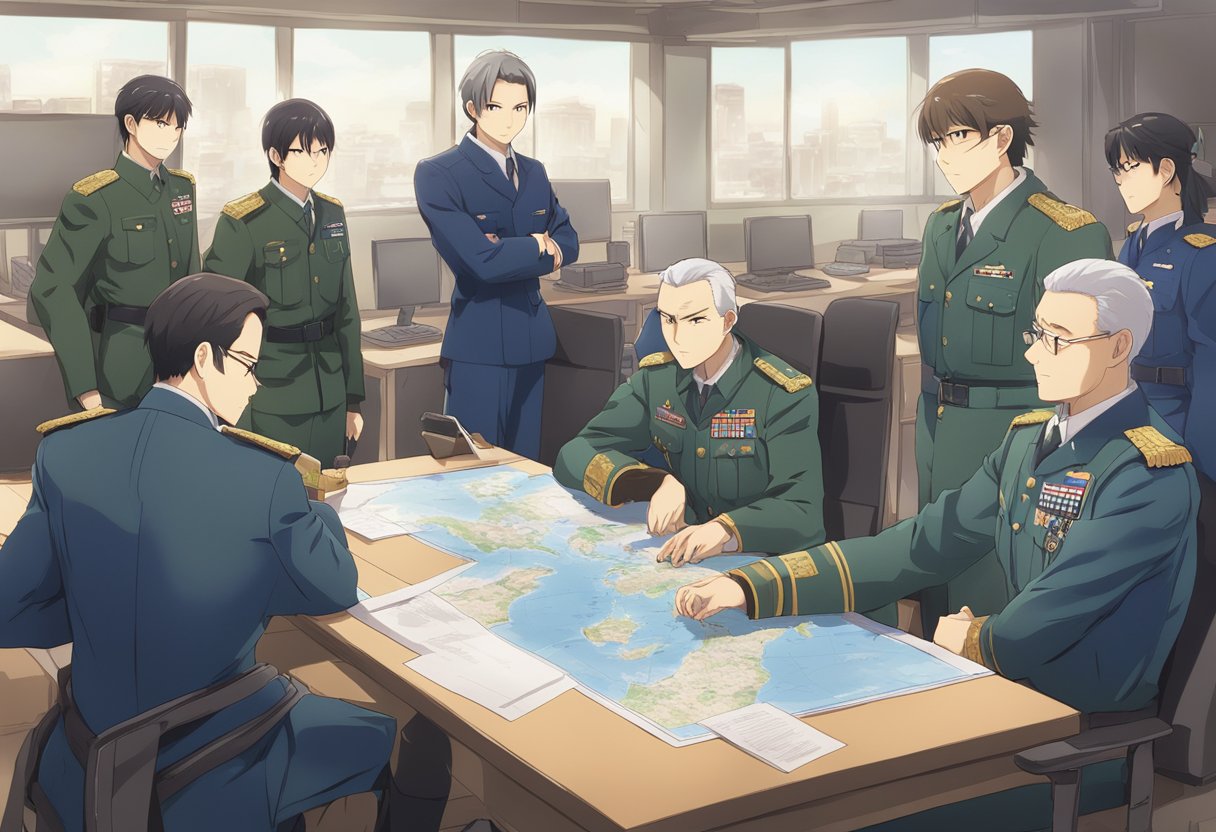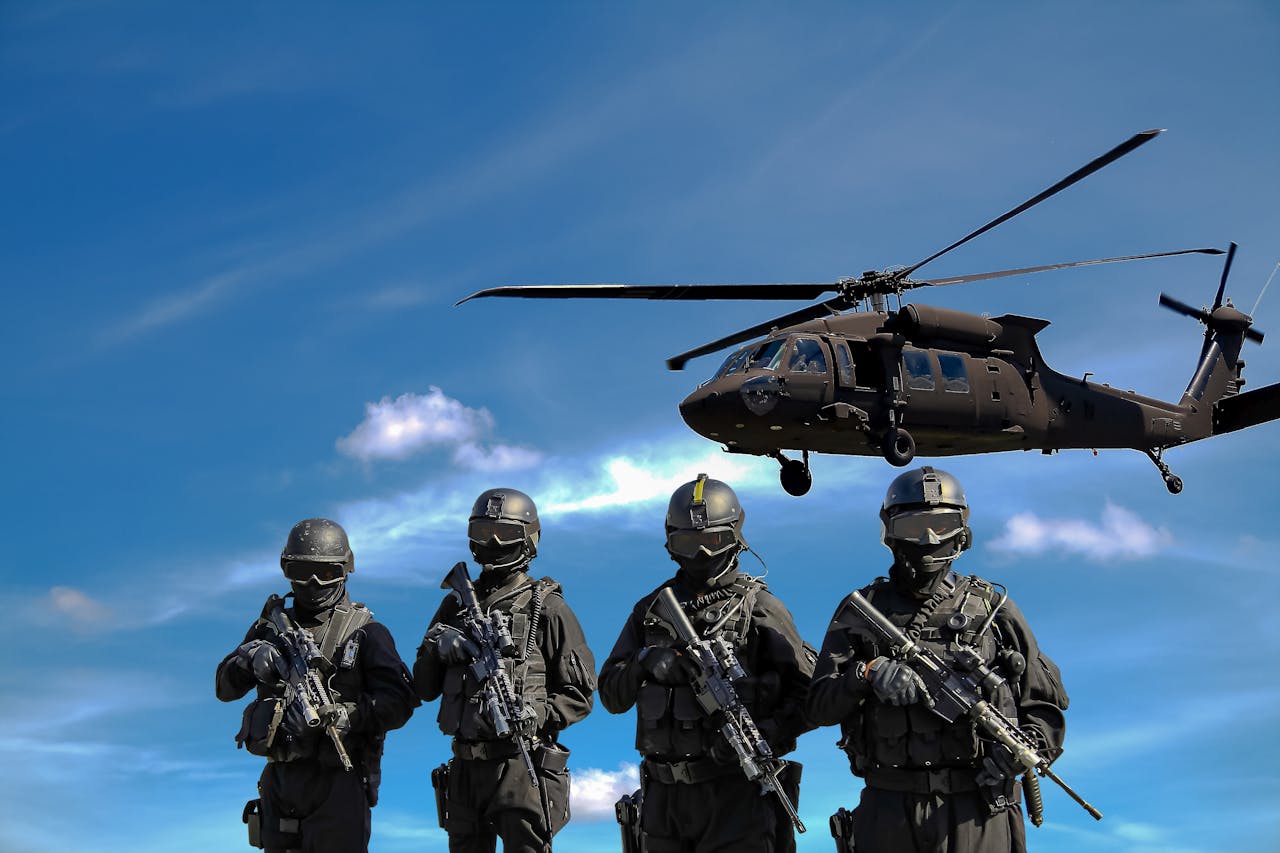Military strategy has long been revered for its complex analysis, decisive action-taking, and robust planning capabilities. These strategies, refined through rigorous training and battlefield experience, are not just confined to the theater of war. They also offer valuable insights for career development, providing a tactical edge in navigating the competitive corporate landscape.
The strategic principles that govern military operations can be adapted to reinforce personal career strategies, setting a stage for methodical advancement and success.


Drawing parallels between military operations and career moves invites an appreciation for meticulous planning, precise execution, and adaptability under pressure.
Leaders in the military are trained to evaluate their environment, make strategic decisions, and act with conviction—all skills that are equally applicable in the business world.
Emphasizing leadership, teamwork, and the ability to stay calm under pressure can help individuals stand out among their peers.
As personal branding becomes increasingly important in the professional realm, the discipline and integrity inherent in military conduct can greatly enhance an individual’s marketability.
Key Takeaways
- Military strategies translate into valuable career strategies through planning and decisive action.
- Leadership and adaptability skills learned from the military are advantageous in the corporate sector.
- The discipline and integrity of military service can elevate personal branding and career growth.
Understanding Military Strategy


In the world of strategic planning, military strategies offer profound lessons in decision-making and leadership that can be transferred to career development. They embody a wealth of historical knowledge and a set of core principles designed to achieve objectives despite adversity.
Historical Examples of Success
Military history provides numerous success stories where strategic acumen led to decisive victories.
One pertinent example is the Inchon Landing during the Korean War commanded by General Douglas MacArthur. This amphibious operation turned the tide in favor of the United Nations forces, showcasing the impact of surprise and audacity in military strategy.
Another illustrative example is the Ia Drang Valley battle during the Vietnam War. It highlighted the use of air mobility by the U.S. Army to land troops into combat, a new implementation of technology in warfare, which defined future military operations.
Key Military Principles
Military principles guide strategic thinking and can enhance career-related skills.
Core principles from the military that are particularly relevant include:
- Clarity of Objectives: Setting clear and achievable goals.
- Unity of Command: Ensuring coherent direction and leadership.
- Economy of Force: Efficient allocation of resources.
- Flexibility: The ability to adapt to changing circumstances.
Understanding and internalizing these principles can provide insights into resource management, leadership, and strategic planning for career growth.
The lessons from military examples like those of General Douglas MacArthur can instill confidence and clarity in one’s career trajectory.
Translating Military Skills to Civilian Careers


When veterans transition from military to civilian careers, recognizing and communicating the value of their military skills is crucial to securing employment.
Identifying Transferable Skills
Veterans possess a variety of transferable skills that are highly valued in the civilian workforce. It’s essential that they identify these competencies:
- Leadership: Military experience often involves leading teams under stressful conditions.
- Problem-Solving: They are trained to assess situations and quickly formulate effective solutions.
- Adaptability: Veterans are accustomed to rapidly adapting to new roles and environments.
By pinpointing soft skills like effective communication, teamwork, and leadership, veterans can demonstrate their capacity to fulfill diverse roles in a civilian career.
Articulating Your Military Experience on a Resume
Articulating military experience on a resume involves translating military-specific language into terms that resonate with civilian employers:
- Position Titles: Convert military titles into equivalent civilian job titles. For example, “Squad Leader” might be translated to “Team Manager”.
- Duties and Achievements: Describe military duties with emphasis on responsibilities and achievements that mirror civilian job requirements.
- Training and Certifications: Highlight relevant training and certifications that align with the targeted civilian job.
A well-crafted resume bridges the gap between military experience and civilian employment expectations, making a veteran’s qualifications clear and compelling to potential employers.
Strategic Planning for Career Advancement
Strategic planning is essential for anyone aiming at career advancement. It structures the pathways to success by aligning ambitions with actionable steps.
Setting Career Goals
Career advancement starts with succinctly defining one’s aspirations and desired career trajectory.
He or she develops a set of career goals which are specific, measurable, achievable, relevant, and time-bound (SMART).
One may choose to segment these goals into short, medium, and long-term categories for better manageability.
For example, a short-term goal could be to improve public speaking skills, whereas a long-term goal might be to achieve a senior management position.
Career Milestones and Performance Tracking
Once goals are set, it’s crucial to establish milestones that signify progress along the career path.
Performance tracking involves regular reviews of these milestones to ensure they are on track for their career wins.
Metrics for tracking performance might include skills acquired, projects completed, or promotions earned.
A table can be an efficient way to monitor milestones:
| Milestone | Target Completion | Status |
|---|---|---|
| Complete leadership training | Q3 2024 | In Progress |
| Lead a major project successfully | Q1 2025 | Pending |
| Obtain a managerial position | Q2 2026 | Pending |
Leadership and Teamwork
Effective leadership and teamwork are pivotal in applying military strategy to a civilian career.
Military leaders are adept at synthesizing their experience and leadership skills to foster teamwork toward a common goal.
Exercising Leadership in a Civilian Context
In the civilian workplace, a former military leader can apply their disciplined approach to orchestrate nuanced strategies.
Leadership within a corporate setting often involves decision-making that impacts both the short-term tasks and the long-term vision.
Just as in the military, where every operation is a shared effort, in the civilian world, leaders must balance individual strengths with team dynamics to overcome challenges.
Example of military-influenced leadership actions in a civilian context:
- Delegation: Assigning tasks based on team members’ strengths and experiences.
- Strategy and planning: Implementing tactical methods for project management.
- Adaptability: Responding swiftly to changes while maintaining focus on objectives.
Building and Leading Effective Teams
Building a cohesive team that operates effectively requires a leader to not only recognize each member’s unique contributions but also to ensure these contributions serve the team’s purpose.
Military experience brings with it a treasure trove of techniques for cultivating dedication and a sense of mission.
Key elements in leading effective teams, informed by military expertise:
- Mission Understanding: Ensuring each team member knows and aligns with the team’s overarching objectives.
- Communication: Keeping avenues open for collaboration and feedback.
- Commitment to Success: Motivating contributions that resonate with the team’s shared objectives.
Competitive Tactics in Business
Incorporating military strategy into business involves a precise understanding of the competitive landscape and the ability to execute effective tactics to secure new opportunities.
These strategies focus on market domination without annihilating competitors, but rather outperforming them to win over customers.
Market Analysis and Positioning
A thorough competitive analysis is critical. Companies must identify strengths, weaknesses, opportunities, and threats through a SWOT analysis.
The goal is to position oneself in the market in such a way that leverages their strengths and protects against competitive forces.
- Strengths: Unique selling proposition (USP) that differentiates a business from its rivals.
- Weaknesses: Areas where the competition is performing better.
- Opportunities: Unexplored or underserved market segments.
- Threats: Emerging competitors or shifts in consumer preferences.
Effective business strategy also means anticipating competitors’ moves.
Businesses must be vigilant and adaptable, ready to respond to changes swiftly to maintain their market positioning.
- Attack: Instead of directly attacking a competitor, companies can focus on outmaneuvering them to capture a larger market share.
- Destroy the Competition: The aim is not literal destruction but achieving victory by winning over happy customers with superior value and service.
Strategies for Winning New Business
To win new business, tactics that translate from military to corporate strategy can be employed.
- Strategies:
- Bold campaign planning.
- Creating alliances for complementary services.
- Leveraging unique capabilities that competitors lack.
The essence of these strategies is to be proactive and innovative.
- New works well when it comes with a clear plan and an understanding of the customer’s needs and trends within the industry.
- Examples:
- Innovation: Offering something new and valuable can draw customers away from the competition.
- Customer Relationships: Building strong bonds with clients can turn them into advocates for the brand.
Adapting to Career Challenges
In any career path, individuals are bound to encounter obstacles that may seem as daunting as navigating a complex military operation.
The key to overcoming such challenges lies in strategic adaptation, much like a military force adjusting to changing battlefield conditions.
One strategizes around hazardous professional setbacks by utilizing an armor of skills and preparation.
This approach includes continual learning and flexible thinking, which are essential to devising effective solutions.
They can rely on their accumulated knowledge to protect their career progression, much like physical armor safeguards soldiers.
To overcome the challenge at hand, it’s important for one to demonstrate boldness.
Being aggressive—not in terms of recklessness, but in the sense of being proactive and decisive—often paves the way to success.
When faced with a difficult situation, they shouldn’t shy away from making bold moves.
Whether it’s spearheading a new project, or pivoting to a different role that aligns better with their skills, these decisions demonstrate their commitment to adaptability.
| Strategies for Adapting | Description |
|---|---|
| Continuous Learning | Stay updated with the latest industry trends and skills. |
| Flexibility | Be open to new roles or responsibilities that may deviate from the original plan. |
| Decisiveness | When a situation demands, make swift and firm decisions to progress. |
By employing such tactics, one positions themselves not just to face career challenges but to use them as a springboard for further professional growth and success.
Integrating Technology and Innovation
In the professional sphere, integrating technology and innovation can be a game-changer, mirroring military strategies where they are critical for achieving a tactical edge.
In one’s career, adopting workable technology is not just about using the latest gadgets; it’s about finding effective solutions that streamline processes and increase efficiency.
Firstly, one must identify which technologies align with their strategic career goals and are feasible within their industry.
They should seek out those that offer competitive advantage, much like the military invests in rapid prototyping to remain agile and effective.
Pilot testing is crucial.
Employers and employees should rigorously test new technologies in controlled environments before full-scale implementation.
Consider how defense organizations evaluate innovations, often through defense innovation organizations (DIOs), to ensure fit-for-purpose before wider adoption.
Collaboration is key.
Just as partnerships between defense tech disruptors and traditional defense organizations can spur advancement, professionals should collaborate across departments.
Sharing insights and knowledge often leads to the emergence of novel concepts that drive innovation forward.
Assess and adapt.
They must continually assess the impact of newly integrated technologies, much like the Department of Defense does to refine military tech (Fostering Innovation).
It’s not a one-off task but an ongoing cycle of improvement to maintain relevance and effectiveness in their career.
Building a Network and Communicating Value
To effectively transition military strategy into a career, individuals must develop robust networks and communicate their value clearly to potential employers.
Utilizing mechanisms akin to military operations, such as strategic planning and targeted communication, can provide a distinct advantage.
Networking is the cornerstone of career advancement.
Participation in job fairs and membership in relevant organizations are opportunities to connect with peers and industry leaders.
These connections often lead to actionable intelligence about job openings and the company culture, similar to how military networks may provide critical information on the field.
Communication is imperative; one must articulate their experiences and skills in terms employers understand.
Tailored marketing campaigns for oneself, which include a professional resume and a personal narrative, facilitate this.
Just as a military campaign requires detailed training and preparation, so does developing an effective personal marketing strategy.
Here’s a quick guide:
- Training: Pursue additional certifications or education to bridge military experience to civilian roles.
- Employers: Research and target potential employers that value military leadership and strategic thinking.
- Communicate: Use clear, concise language to demonstrate transferable skills and how they apply to business challenges.
- Job Fairs: Attend with a prepared elevator pitch that summarizes one’s value proposition.
- Membership: Join professional groups that align with career goals to gain insights and establish connections.
- Marketing Campaigns: Create personalised assets like a resume or LinkedIn profile that highlight one’s unique qualifications and experiences.
When transitioning from military to civilian employment, veterans must strategize in order to effectively navigate career logistics.
Drawing on resources such as military.com can be extremely beneficial.
The precise execution of logistics in a military context transfers well to organizing a civilian job search.
- Research: Begin with thorough reconnaissance of the job market.
- Identify job postings that match one’s skills.
- Aggregate insights from various guides and platforms.
- Planning: Develop an operational career plan.
- Outline short and long-term goals.
- Create a timeline for achieving these objectives.
- Execution: Apply military precision to follow through.
- Tailor resumes to individual jobs.
- Practice interview techniques reflecting one’s preparedness.
- Adaptation: Be ready to adjust tactics.
- Analyze feedback from applications.
- Refine strategies as per the job market dynamics.
Interpreting and Learning from Military Histories
Interpreting and learning from military histories allows individuals to draw on the wisdom of past strategies and understand the nature of leadership and decision-making under pressure.
By dissecting historical military events, one can extract lessons applicable to contemporary career challenges.
Analyzing Battlefield Strategies
Analyzing historical battlefield strategies provides insights into larger concepts such as strategic planning, resource allocation, and leadership.
For instance, examining General Douglas MacArthur’s bold Incheon Landing during the Korean War reveals the value of surprise and audacity in overcoming obstacles.
It also showcases the extensive planning and deception required to land troops on Inchon’s beaches, outflanking the North Koreans.
In the context of the Vietnam War, Lieutenant Colonel Hal Moore demonstrated true leadership and determination under harrowing conditions at the Battle of Ia Drang.
By examining Moore’s command decisions, one grasps the importance of adaptability and morale in leading a combat unit against overwhelming odds.
His collaborative approach with Sergeant Major Plumley exemplifies how joint efforts can fortify a team’s resolve in critical situations.
Applying Historic Tactics to Modern Challenges
The use of historic military tactics can inform modern-day problem-solving and strategic thinking.
The D-Day invasion offers lessons in logistical coordination and the importance of detailed operational planning.
The Allied forces’ preparation and execution of landings across multiple beaches reflect the necessity of synchronized actions in complex initiatives.
H.R. McMaster, who served in the Gulf War, illustrates how a contemporary understanding of historical conflicts can benefit strategic thought.
His critique of military leadership and strategy, drawn from his experiences in SW Iraq, reinforces the idea that historical awareness is intrinsic to improvement and success in current environments.
Furthermore, the US Navy’s strategies during Normandy have been adapted in modern settings where precise and well-timed execution of complex projects is vital.
Drawing on these past experiences, from the American Infantry in World War II to the Army Air Force and their revolutionary tactics, professionals in a range of careers can adapt these time-tested approaches to leadership, problem-solving, and strategic planning within their own fields.
Personal Branding and Career Marketing
In the realm of career advancement, personal branding serves as the strategic representation of an individual’s professional persona. It is closely akin to how organizations manage their brand identity within the marketplace.
Just as a well-crafted marketing campaign can elevate a product’s position, effective personal branding positions a professional for greater opportunities in their career.
Key Strategies:
- Identify Core Competencies: Just as a new product’s unique selling points are highlighted, individuals should identify their strengths and skills that set them apart.
- Consistent Messaging: Employ the consistency of military communication to reinforce personal branding across all platforms.
- Strategic Networking: Utilize personal leadership skills to establish and maintain a network that aligns with career goals.
Marketing Oneself:
- Sales Techniques: Adopt sales principles to market skills and experience effectively to potential employers or clients.
- Social Proof: Gather endorsements and testimonials to support claims of expertise, much like customer reviews in a marketing campaign.
Building a Tactical Plan:
- Set clear objectives.
- Define target audience.
- Develop a value proposition.
- Outline the tactics to reach goals, such as professional development or new certifications.
Employing Additional Resources:
-
- LinkedIn Learning offers insights on how military veterans can harness personal branding strategies.
- Publications like “Success After Service” provide tools for translating military experience into marketable traits.
Leveraging Military Discipline
Military discipline has long been esteemed for its application in organizational and personal success.
In career planning and execution, the tenets of military discipline can provide individuals with a structured approach to achieve their professional objectives.
Consistency and Routine
One key aspect of military discipline is the establishment of solid daily routines.
Career-focused individuals can benefit from setting and adhering to regular schedules for their work, which might include dedicated times for skill development, networking, and planning next career moves.
Maintaining High Standards
The military’s emphasis on high standards can translate into an unwavering commitment to quality in the workplace.
Professionals should aim to consistently deliver exemplary performance, mirroring the military’s expectation of excellence in all undertakings.
-
-
- Clear Objectives and Strategies
A military strategist understands the importance of clear objectives.
- Clear Objectives and Strategies
-
- Career professionals need to set specific, measurable, achievable, relevant, and time-bound (SMART) goals and develop strategies to meet them.
-
| Military Concept | Career Application |
|---|---|
| Chain of command | Respect hierarchy |
| Situational awareness | Understand the work environment |
| Strategic planning | Career planning and advancement |
Handling Pressure
The ability to maintain composure under pressure is a hallmark of military discipline.
In the corporate world, this can translate to managing stress effectively and making calm, informed decisions in high-stakes situations.
Flexibility and Adaptability
While discipline implies structure, it also requires flexibility.
Successful military operations often depend on the ability to adapt to changing conditions.
Likewise, in a career, individuals should be prepared to pivot and embrace new methods or paths when necessary.
Maximizing Team Synergy
In the context of career development, leveraging military strategy such as a combined arms approach can be instrumental in fostering stronger team synergies. This strategy emphasizes the use of diverse skills and resources to achieve a common goal.
Forming a Combined Arms Approach
Teamwork is the cornerstone of any combined arms approach.
By integrating the distinct capabilities of tanks and infantry fighting vehicles, military operations can cover each other’s weaknesses and amplify their strengths.
In a career setting, this translates to creating cross-functional teams where each member brings unique expertise to the table.
For instance, in a project involving customers, including team members with direct customer service experience alongside product developers can result in a more comprehensive understanding of client needs.
The former can offer practical insights into customer interactions, while the latter can adapt that feedback into tangible product enhancements.
-
-
- Tanks (Heavy Hitters): In a business environment, these are the team members with deep industry knowledge or specialized skills that can navigate through complex challenges.
- Infantry Fighting Vehicles (Agile Support): Other team members who may be more versatile and adapt quickly to changing situations, supporting the heavy hitters.
-
By deploying a combined arms team within a workplace, an organization can maximize its operational effectiveness.
Team members are encouraged to collaborate, leading to a more agile and responsive approach to both internal and customer-focused challenges. Through this synergy, a team can achieve greater success than individually working in silos.
Maintaining Ethical Standards and Integrity
In the realm of military strategy, ethical standards and integrity are foundational elements that ensure cohesive and effective operations.
Similarly, in any career, maintaining rigorous ethical standards is non-negotiable for those aspiring to be seen as credible and trustworthy professionals.
-
-
- Illustrated Integrity: Integrity is more than just a concept; it is action-oriented.
It involves leading by example, where actions align with words.
Great leaders in the military are often celebrated for their unwavering adherence to honest and ethical conduct. By embedding this virtue into everyday work, individuals solidify their reputational standing and empower their teams.
- Accountability Measures: Just as ethical leadership in the military is pivotal, in a career setting, accountability structures foster a culture of dependability.
Employees are encouraged to take ownership of their actions, thereby promoting a transparent work environment.
Regular self-assessment and peer review are tools that mirror military practices which support a strong ethical framework.
- Training for Ethical Dilemmas: The military invests in ethical leadership development to equip leaders with the skills needed to handle complex moral decisions.
In careers across the board, continuous training on ethical practices can prepare individuals to face and resolve ethical challenges competently.
- Cultivating Ethical Culture: A leader’s investment in ethical practices influences the broader workplace culture.
The focus of ethics education in military training reflects the necessity of instilling a deep-rooted ethical mindset at all levels.
In the corporate world, fostering a similar culture where integrity is prized creates an environment where everyone feels a collective responsibility toward ethical decision-making.
- Illustrated Integrity: Integrity is more than just a concept; it is action-oriented.
-
Conclusion
Incorporating military strategy into one’s career development offers a structured mindset for advancing professional goals. It encourages a team-centric approach and the application of strategically planned bold moves. Reviewing historical military tactics, one can draw parallels between these techniques and career progression tactics.
-
-
- Strategic Planning: Just as military operations require meticulous planning, career moves benefit from a well-thought-out strategy.
- Boldness in Action: Times when boldness can be a catalyst for career advancement reflect the benefit of decisive action, a principle observed in military strategy during pivotal conflicts.
-
Recognizing that success is often the result of collective effort is vital. Leaders in military history frequently emphasize the importance of cohesive teamwork, an aspect directly applicable to the workplace.
Adapting military strategy to a non-military context is not about adopting a combative stance but rather about embracing the clarity and efficiency of military planning methodologies.
This practice is not limited to individuals with military training but is applicable to anyone seeking to enhance their career through structured and principled planning.
It is about setting clear objectives (ends), determining the best methods (ways), and utilizing the appropriate resources (means).
The effective application of these concepts can foster professional growth and the achievement of career milestones. In essence, the principles of military strategy, when leveraged properly, can be a powerful tool for strategic career management.
Frequently Asked Questions
Incorporating military strategies into a career framework can significantly bolster both leadership and operational effectiveness. This section probes into how military strategies can be effectively translated into the corporate world, enhancing various facets of professional development.
What are effective ways to implement military strategies in corporate leadership?
Corporate leadership benefits from military strategies by fostering decisiveness and strategic foresight.
An example is the use of the OODA Loop—Observe, Orient, Decide, and Act—which enhances the ability to make quick and informed decisions in a fast-paced business environment.
How can principles of military strategy improve project management skills?
Applying principles of military strategy to project management can improve efficiency and adaptability.
For instance, the seven-step military problem-solving process can be used to systematically identify solutions and streamline project workflows.
What aspects of military strategy can enhance decision-making in business?
Business decisions benefit from military strategy through the emphasis on objective analysis and situational awareness.
This results in informed, calculated actions rather than reactive ones, a principle that mirrors the rigorous planning seen in military operations.
In what ways can military tactical discipline be applied to team management?
Military tactical discipline, when applied to team management, underscores the importance of cohesion and accountability.
Techniques such as clear communication of objectives and consistent enforcement of standards can strengthen team performance and unity.
How do military strategic planning techniques translate to risk management in a career?
The military’s methodical approach to analyzing and mitigating risks is directly applicable to career risk management.
Identifying potential pitfalls and developing contingency plans ensures a proactive rather than reactive approach to challenges.
What can we learn from military strategists about competitive analysis in a professional setting?
Military strategist’s meticulous approach to competitive analysis sheds light on understanding the competitive landscape.
It highlights the need to evaluate rivals’ strengths and weaknesses and adapt strategies accordingly for a competitive edge in the professional arena.





